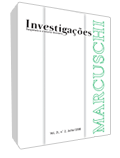Rotinas interativas mãe-bebê: constituindo gêneros do discurso
Abstract
Este artigo busca mostrar as primeiras interações entre mãe e bebê envolvendo o uso de gêneros do discurso dentro da esfera familiar, mostrando como, a partir das estratégias de atenção conjunta, as rotinas interativas começam a se organizar em torno de gêneros orais diversos: como a conversa, o jogo, a história, as cantigas. Para isso, trabalho com autores como Bruner (1983) Tomasello (2003) e McNeill (1985) no que diz respeito à aquisição da linguagem e gestualidade, respectivamente; e Bakhtin (1979), no que se refere aos gêneros textuais.References
BATES, E.; CAMAIONI, L.; VOLTERRA, V. 1979. The Acquisition of Performatives Prior to Speech. In: OCHS, E.; SCHIEFFELIN, B. B. (orgs.). Developmental Pragmatics. London: Academic Press.
BRUNER, J. 1978. The ontogenesis of speech acts”. Journal of child language. Vol. 2 Nº 1. Cambridge: CUP.
______. 1983. Childs Talk. Oxford: OUP.
BUTCHER, C.; GOLDIN-MEADOW, S. 2000. Gesture and the transition from one-to-two-word speech: when hand and mouth come together. In: MCNEILL, D. (ed.). Language and gesture. Cambridge: CUP.
CAVALCANTE, M. C. B. 1994. O gesto de apontar como processo de co-construção nas interações mãe-criança. Dissertação de Mestrado, UFPE. ______. 1999. Da voz à língua: a prosódia materna e o deslocamento do sujeito na fala dirigida ao bebê. Tese de Doutoramento, IEL/UNICAMP. ______.; NASLAVSKY, J. P. N. A matriz inicial da subjetividade tendo como locus a dialogia do/no manhês. In: BRIAN, A.P.; SILVA, M. Silva; LYRA, M. (orgs.). Microgênese: Estudo do Processo de Mudança. (A sair pela ARTMED).
CLARK, E.V. 1978. From Gesture to Word: On the Natural History of Deixis in Language Acquisition. In: BRUNNER, J. S. Brunner; GARTON, A. (eds.). Human Growth and Development. Oxford: Clarendon Press, p. 85-117.
DE LEMOS, C. T. G. 1986. interacionismo e aquisição de linguagem. Revista D.E.L.T.A. Vol. 2. São Paulo: Editora da PUC-SP.
______. 1992. Los processos metafóricos y metonímicos como mecanismos del cambio. Substratum, vol.1, n. 1.
______. 1995. Língua e discurso na teorização sobre aquisição da linguagem. Letras de Hoje, no. 4.
GOLDIN-MEADOW, S. 1993. When does gesture become language? A study of gesture used as a primary communication system by deaf children of hearing parents”. In: GIBSON, K. R.; INGOLD, T. (eds). Tools,Language and Cognition in Human Evolution. Cambridge: CUP.
______.; ALIBALI, M.; CHURCH, R. B. 1993. Transitions in concept acquisition: Using the hands to read the mind. Psychological Review 100 (2): 279-297.
______.; WEIN, D.; CHANG, C. 1992. Assessing knowledge through gesture: Using children's hands to read their minds. Cognition and Instruction 9 (3): 201-219.
KENDON, A. 1982. The Study of Gesture: someremarks on its history. Recherches sémiotiques/semiotic inquiry 2: 45-62.
______. 2000. Language and Gesture: Unity or Duality? In: MCNEIL, D. (ed.), Language and Gesture. Cambridge: CUP, pp. 47-63.
LAVER, J. 1991. The Gift of Speech. Papers in the Analysis of Speech and Voice. Edinburgh: Edinburgh University Press. pp. 235-264.
______. 2000. Unifying principles in the description of voice, posture and gesture. In: CAVE, C. ; GUAITELLA, I. Interations et comportement multimodaux dans la communication. Paris: L’Harmattan.
______.; TRUDGILL, P. 1979. Phonetic and linguistic markers in speech". In: SCHERER, K.; GILES, H. (eds). Social Markers in Speech. Cambridge: CUP, p. 1-32.
______. ; HANSON, R. 1981. Describing the normal voice. In: DARBY, J. (ed.). Evaluation of speech in psychiatry. New York: Grune & Stratton, p. 51-78.
MARCUSCHI, L. A. 2005. Oralidade e Letramento como práticas sociais. In: MARCUSCHI, L. A.; DIONISIO, A. P. (orgs.), Oralidade e Escrita. Belo Horizonte: Autentica/MEC/CEEL.
MCNEILL, D. 1985. So you think gestures are nonverbal? Psychological Review. Vol 92(3): 350-371.
______. 2000. Introduction. In: MCNEILL, D. (ed.). Language and Gesture. Cambridge: CUP.
MORATO, E. M. 2004. O interacionismo no campo lingüístico. In: MUSSALIM, F.; BENTES, A. C. (orgs.). Introdução à lingüística: fundamentos epistemológicos, Vol. 3. São Paulo: Cortez.
TOMASELLO, M. 2003. Origens Culturais da Aquisição do Conhecimento Humano. Trad. Cláudia Berliner. São Paulo: Martins Fontes.
______. 1995. Understanding the self as social agent. In: ROCHAT, P. (ed.). The Self in Early Infancy. Theory and Research: 449-460. Amsterdam: Elsevier.
______.; TODD, J. 1983. Joint attention and lexical acquisition style. First Language, 4:197-212.
WERNER, H.; KAPLAN, B. 1963. Symbol Formation.Worcester: Clark University.
Downloads
Published
How to Cite
Issue
Section
License
Copyright (c) 2008 Marianne Carvalho Bezerra Cavalcante

This work is licensed under a Creative Commons Attribution 4.0 International License.
Authors who publish with Revista Investigações agree to the following terms:
Authors retain copyright and grant the journal right of first publication with the work simultaneously licensed under the Creative Commons Attribution 4.0 International (CC BY 4.0) license that allows others to share the work with an acknowledgement of the work's authorship and initial publication in this journal.
Authors are able to enter into separate, additional contractual arrangements for the non-exclusive distribution of the journal's published version of the work (e.g., post it to an institutional repository or publish it in a book), with an acknowledgement of its initial publication in this journal.
You are free to:
Share — copy and redistribute the material in any medium or format for any purpose, even commercially.
Adapt — remix, transform, and build upon the material for any purpose, even commercially.
The licensor cannot revoke these freedoms as long as you follow the license terms.
Under the following terms:
Attribution — You must give appropriate credit , provide a link to the license, and indicate if changes were made . You may do so in any reasonable manner, but not in any way that suggests the licensor endorses you or your use.
No additional restrictions — You may not apply legal terms or technological measures that legally restrict others from doing anything the license permits.

